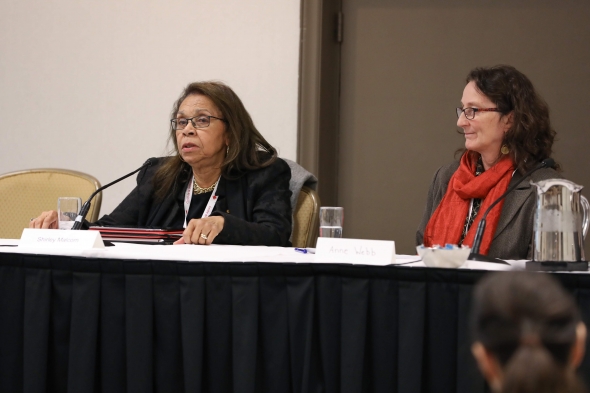Theme 1: Science and Policy

Day 2 – November 8th 2018
Takeaways and recommendations:
Federal-Provincial Coordination in Research and Innovation Funding
Organized by: University of Toronto, Emina Veletanlic and Creso Sá, PhD
Speakers: Emina Veletanlic, University of Toronto, PhD Student, CIHE-OISE and Manager, Strategic Initiatives, Impact Centre; Dr. Marc Fortin, Vice-President, Research and Partnerships, Natural Sciences and Engineering Research Council of Canada; Dr. David Moorman, Senior Advisor, Policy & Planning, Canada Foundation for Innovation; Dr. Merli Tamtik, Assistant Professor, Department of Educational Administration, Foundations and Psychology, Faculty of Education, University of Manitoba
Moderators: Dr. Creso Sá, Professor of Higher Education and Director, CIHE-OISE,
University of Toronto
Takeaways and recommendations
- Panelists discussed a paper released in October by the Impact Centre and CIHE titled, “A Delicate Balance: Federal-Provincial/Territorial Coordination in Research and Innovation Funding”
- Provinces and territories fund approximately 30% of post-secondary research. The current funding reality is an “uncoordinated entanglement”, with fragmented funding, too much complexity and unequal spread of funding across disciplines and institutions.
- Coordination is a long-standing problem. Even earlier reports on Canada’s system cited this as an issue (e.g., see LeRoy and Dufour, ‘Partners in Industrial Strategy. The Special Role of the Provincial Research Organizations’, 1983).
- Coordination is a multifaceted process. It is “messy” and “difficult to measure and track”.
- A number of elements could be used to promote better coordination on particular policy issues, thus helping us move from talk to action:
- Improve policy framing on issues that are shared between provincial and federal science funding organizations.
- Include all relevant stakeholders in decision making.
- Create a venue with opportunities for meaningful interactions.
- Review the range and coherence of policies and consider how to ensure complementarity.
- Examine instruments, programs and potential interventions and understand how the programs reinforce each other.
- Create system-level instruments that oversee the efforts of the whole.
- Coordination is a massive challenge for federal systems. Systemic barriers are inherent in the federal model: federalism codes barriers into the system through the existence of federal/provincial jurisdictions.
- The governance of education is explicitly mentioned in the Constitution as the exclusive responsibility of the provinces, but research is not defined.
- Vertical funding support between the provincial and federal systems is required.
- We need to be inclusive in consulting about science policy. Science policy also lacks recognition of Indigenous systems. Colleges are often not consulted; they need to be part of the conversation.
- Administratively, we are not rewarded for policy coordination. We must make policy coordination a priority.
- Federal granting agencies and Health Canada should review funding programs, focus on filling any gaps, and work to promote more interdepartmental coordination.
- There are no dedicated mechanisms to allow more effective collaboration between policy and granting research agencies.
- The research community can be more vocal and advocate for more coordination.
- Canada needs a strong national framework for innovation and a strategic plan. We currently have competing priorities across the country.
- We also have to consider coordination beyond our national borders. We need to define our ambitions for science on the international stage.
- There is also a duplication of the peer review process between provinces and federal granting agencies. The Ontario Centres of Excellence and NSERC are among those coordinating to eliminate this duplication through mechanisms that allow applicants to fill out single applications and undergo only one review process.
- Any strategy going forward must begin with understanding how resources are currently allocated.
- Thanks to the Fundamental Science Review, the challenges at the federal level are well known, but we still need better data on coverage gaps at the provincial and territorial levels.
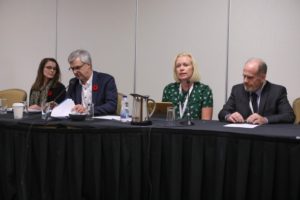
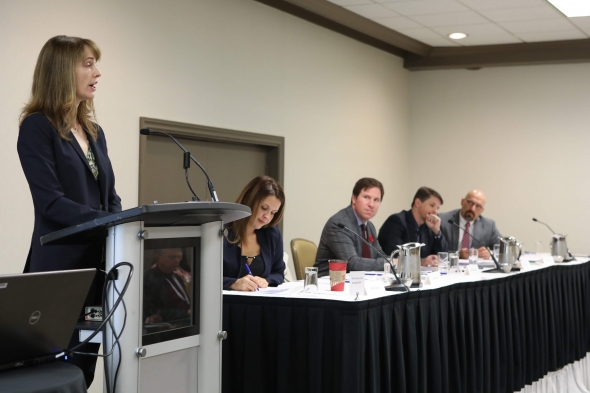
Day 1 – November 7th 2018
Takeaways and recommendations:
Should regulators define their risk tolerances? A debate
Organized by: Canadian Food Inspection Agency, Alyssa Daku
Speakers:
Against setting risk tolerance standards:
- Pierre Bilodeau, Executive Director, Plant Health Science Directorate, Canadian Food Inspection Agency
- Greg Paoli, Principal Risk Scientist, COO, Risk Sciences International
In favour of setting risk tolerance standards:
- Liane Sauer, Director General, Strategic Planning, Canadian Nuclear Safety Commission
- Robert Wiersma, Manager, Public Safety Risk Management, Technical Standards and Safety Authority, Ontario
Moderator: Alyssa Daku, Chief Data and Risk Executive, Canadian Food Inspection Agency
Takeaways and recommendations
- Although setting risk tolerances is widely regarded as an essential and mandatory policy function for regulatory institutions, the question around whether regulators can and must set risk tolerance levels is a contentious and largely debated issue.
- Recognizing that zero risk is not achievable (practical or resource wise), regulators must distinguish levels of risk that cannot be tolerated from those that can be, and in doing so, make value-driven decisions that offer the greatest benefit in protecting the public and in the most cost effective manner.
- However, for all the reasons that advocate the benefits of establishing risk tolerance levels, there are just as many reasons demonstrating their limitations on the regulator, the extent to which they help mitigate the risk, and potential implications on trade to name a few.
- Regulators should approach the subject of risk tolerance on a case by case basis that considers the societal risks and benefits, legal and policy requirements, ethical considerations and economic ramifications.
Defining risk
- Concrete, measurable risk tolerances provide a basis for useful comparisons of risks and policy options which serve all segments of society, and helps society make better, more informed, choices.
- Such assessments can also be offered to the public and create a citizenry better informed of the risks they face in their lives.
- People typically make their own intuitive judgements about the levels of risk they face, something that is made more explicit when public bodies offer their own assessments to support or deny those judgements.
- By creating a greater awareness of the issues and ethical value judgements regulators make about risk, the decision-making process that leads to laws or regulations will become more transparent, which may in turn contribute to public acceptance of restrictions on behaviour. If the public understands how these tensions and value judgements are resolved, they are more likely to buy into any decision.
- However, decisions around risk can vary widely, as can their definition, such as the difference between road accident rates based on the number of people travelling versus the number of kilometres travelled.
- Despite attempts to foster transparency, established risk tolerance levels may be unclear or unacceptable to many observers, which can work against efforts to gain public trust.
Challenges of setting risk tolerance
- In spite of a tacit assumption that universal standards are the only acceptable way to manage risk, but we have been able to succeed and progress as a society in the absence of such standards
- Different cases call for different approaches to defining the management of a problem; for example, with invasive species there may be a demand that no level of pest presence is acceptable, which puts regulators in the difficult position of trying to determine if these pests are in fact absent or they have not yet been found; in contrast, studies of diseases in plants or livestock can be referred to established health guidelines, which can serve as a basis for how serious a risk a disease poses to health.
Communicating risk tolerance
- Transparency can also depends on the application of scientific evidence to justify a particular standard, which leaves open the possibility that such evidence could evolve over time, necessitate changes to such standards, and possibly undermine public confidence in the organization that set the original standard.
- Risk tolerances also reflect an assessment of what is technically possible to achieve; an industrial standard that can be attained by 100 per cent of firms may be too low to achieve the desired level of public safety, but raising it may lead to other practical problems that tax regulatory resources.
- The distinction between allowing something and preventing may be based on a subtle negotiation between regulators and society to enable factors such as cultural practices or historical usage to determine the level of risk associated with particular products, such as natural health remedies that might otherwise been deemed unsafe.
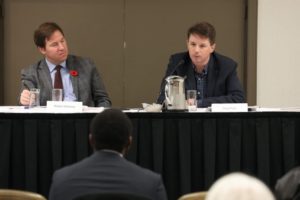
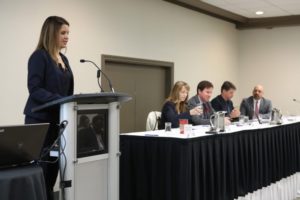
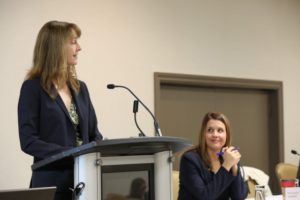
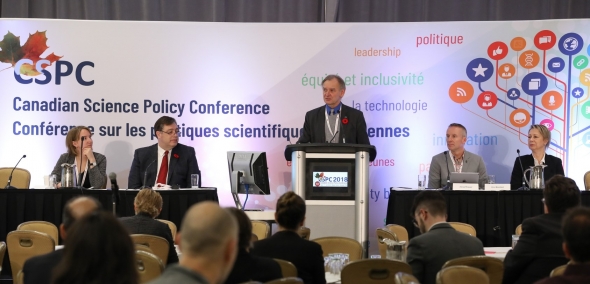
Day 3 – November 9th 2018
Takeaways and recommendations:
How Canada can create a sustainable national space infrastructure
Organized by: Space Advisory Board, Michelle Mendes
Speakers: Kate Howells, Global Community Outreach Manager and National Coordinator for Canada, The Planetary Society; Dr. Gordon Osinski, NSERC/MacDonald, Detwiller and Associates Ltd/Canadian Space Agency Industrial Research Chair in Planetary Geology, Western University; Dr. Michael Pley, President, Pley Consulting Inc.; Dr. Marie Lucy Stojak, Executive Director, Mosaic
Moderator: Dr. David Kendall, Past Chair of the United Nations Committee on the Peaceful Uses of Outer Space (2016-2017)
Takeaways and recommendations
Challenges facing Canada’s space sector
- Canada has diminished the academic and industrial base that was developed between 1960 and 2005. It has also tarnished Canada’s brand internationally by not participating in international missions.
- In 1992 Canada was the 8th ranked nation in terms of percentage of GDP spending in space. Today we are 18th.
- There are expected to be significant job losses in Canada’s space sector over the next two years as a result of a changing commercial market (i.e., from large to small satellites), and by Canada’s decision to pass on all recent space opportunities. (i.e., the next two Mars missions in 2020 will not have Canadian instruments on board.)
- Space science is driven by big missions to answer big questions like our place in the universe and the origin of life. Our lack of participation in upcoming space missions means this pipeline of talented students will continue to leave Canada for jobs elsewhere.
- Most industrial players in space rely on both the commercial markets and government procurement to survive. Stagnant investments in space and the lack of a current long-term space have resulted in companies relying even more on commercial markets, making it difficult for many to scale up.
- The global space sector is changing dramatically and quickly with the emergence of “NewSpace”, which encompasses a globally emerging private spaceflight industry driven by technology advances like small satellites and new commercial opportunities such as selling space data.
- Canadian companies are looking to other countries for investment, which increases the risk of capital, HQP and R&D leaving Canada
- Sixty nations now have space plans – Canada is not one of them.
An action plan for Canada
- The Aerospace Review Report (2012), the Aerospace Innovation White Paper (2015) and the Space Advisory Board report (2017) all urge Canada to think of space as a national strategic asset.
- Canada urgently needs a government framework for space, or a long-term space plan with missions in the pipeline and sustainable funding. Canada’s last long-term space place was released in 1994.
- Canada needs a balanced of portfolio, from space exploration to earth observation, and over a period of time so there is always something in the pipeline.
- Adopt new policies and regulations to encourage rapid growth in the space industry and the economy. (e.g., the U.S. is relaxing its regulatory framework for launch and re-entry).
- Canada should consider passing legislation, as other countries have done, to stimulate space science (e.g., requiring certain agencies to direct part of their budget to space science).
- Asteroid mining should be a natural for Canada, considering our long history and expertise in mining. Partner with countries that are active in this space (e.g., Luxemburg, U.S.).
- Like other countries, Canada needs clear policies and regulations that favour buying domestic space services and products, and not launch or operate services that are already available commercially.
- Canada’s rationale for investing in space should not be motivated by what other countries are doing; rather, these are investments that will deliver real value to Canadians. However, we can learn from relevant ideas in other countries. (e.g., European Union contracts require companies to allocate a percentage of the contract’s value to outreach and education.)
- Canada needs to invest more in outreach and education. A September 2018 Ipsos poll found Canadians have little awareness of Canada’s space achievements beyond the Canadarm and astronauts.
- As space becomes more global, there is a need to coordinate activities (e.g. security of satellites). Canada needs to participate or the rules will be written by others.
- Consider establishing a separate federal ministry for space, as has been done in the U.K., with links to other government departments.
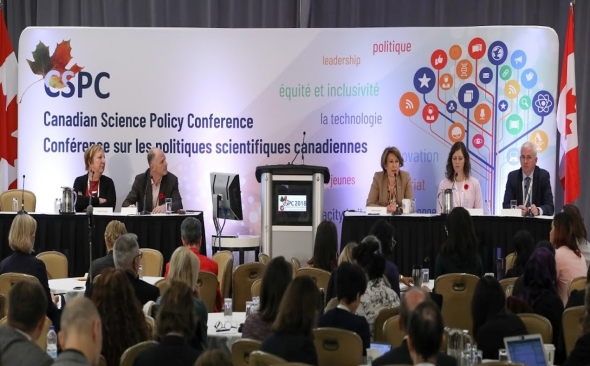
Day 3 – November 9th 2018
Takeaways and recommendations:
Science and the next generation: partnerships and collaborative infrastructure as enablers
Organized by: Public Services and Procurement Canada, Anne-Marie Thompson
Speakers: Dr. David Castle, Vice-President Research, Professor in the School of Public Administration with an adjunct appointment in the Gustavson School of Business, University of Victoria; Dr. Martha Crago, Vice-Principal, Research and Innovation, McGill University; Dr. Stacey Robinson, Research Scientist at Environment and Climate Change Canada; Adjunct Professor at Carleton University; Dr. Dan Wicklum, Chief Executive, Canada’s Oil Sands Innovation Alliance (COSIA)
Moderator: Dr. Mona Nemer, Chief Science Advisor, Government of Canada
Transformation of federal labs is opening new doors for collaboration
Canada’s third largest R&D spender – the federal government – wants to collaborate more with the country’s two larger R&D spenders, academia and industry.
Canada’s Chief Science Advisor said Canada’s $2.8-billion commitment to renew federal research infrastructure and labs is a “once in a lifetime opportunity” to foster new collaborations with academia, the private sector, and even with other government departments.
“The idea is not to make new buildings which mimic the older ones, or move people to from one location to another,” Dr. Mona Nemer told CSPC delegates. “There’s much more to it than this.”
Dr. David Castle, Vice-President Research at the University of Victoria (UVic), stressed that this is not a “renovation” of government labs. Rather, he said this unprecedented investment will “transform how science is done in the country”.
Proven collaborative models
The panel speakers provided several examples of existing models that could inform the government’s approach to making its massive inventory of federal labs more collaborative.
One success in the private sector has been Canada’s Oil Sands Innovation Alliance (COSIA), which has seen oil sands producers pool resources to improve the industry’s environmental performance. COSIA works with a network of 40 associate members, including universities, small and mid-sized companies and governments to identify the most pressing innovation needs of the sector.
“Instead of each individual company developing technology and holding it for themselves, they share it, so essentially we can leverage capacity, resources and funding and accelerate the pace of innovation,” said COSIA Chief Executive Dr. Dan Wicklum.
COSIA focuses its approach on two drivers: identifying actionable challenges facing member companies, and providing companies with access to testing infrastructure to validate new technologies.
But Wicklum cautioned that this “market pull doesn’t just happen. You really have to work at it in very deliberate ways so that the innovators are being pulled. Our major tool to break down that barrier is this joint articulation of need.”
The first step is asking companies what they need. COSIA members identified 90 technology gaps or needs which the alliance has condensed into 19 technology challenges that anyone can respond to, whether they be external companies, academic researchers, or other research institutes.
For example, COSIA has launched the Carbon XPRIZE, which will award $20 million to the teams that can best take carbon dioxide from flue gas stream and turn it into a valuable project. “Unless you have people to nudge that new sector (carbon, capture and utilization) along, it won’t happen by itself,” said Wicklum.
Castle said a similar approach is needed when the federal labs collaborate with non-government scientists. The first step is to understand each research community’s culture of practice and to ask if their research is being inhibited by a lack of access to certain infrastructure.
“Then work collaboratively between people who have the infrastructure and those who don’t or develop joint proposals to secure something they will then share,” said Castle. “It has to start with the nature of scientific work they want to do and then get people to prioritize and align directions.”
For example, Castle said the 50-year-old Triumf particle physics lab in Vancouver BC “is a really great example of the way universities, the government and the private sector use a very sophisticated platform to achieve their individual and mutual ends”.
UVic is currently reviewing how its research infrastructure, both on and off campus, can spur more opportunities to do collaborative research with the federal government. For example, Castle said UVic used monies from the Post-Secondary Institutions Strategic Investment Fund to renovate a 25,000 sq. ft. building on campus that is now home to the CFI Major Science Initiatives-funded Ocean Networks Canada.
The space will also accommodate two Environment and Climate Change Canada (EEEC) labs, as well as the newly created World Data System International Technology Office (ITO). Other Canadian partners in the ITO are the National Research Council’s (NRC) Canadian Astronomy Data Centre, the Canadian Cryospheric Information Network/Polar Data Catalogue (Canadian Space Agency, Meteorological Service of Canada, Natural Resources Canada).
“We don’t have a particular design in mind for what the science will evolve to become over the years, we’re simply using geography as an opportunity to see what kind of cross fertilization can happen,” said Castle.
Off Campus, he said there is an opportunity to transform some of UVic’s biological sciences research by sharing space at the Canadian Food Inspection Agency’s new Centre for Plant Health, which will be built over the next five years in Sidney, BC.
ECCC also partners with Carleton University to run the largest wildlife toxicology lab in Canada. At nearly 6,000 square metres, the National Wildlife Research Centre (NRWC) houses 15 labs, research greenhouses and a wildlife specimen storage facility.
Dr. Stacey Robinson, an ECCC research scientist, said the physical design of the facility “allows for a lot of conversations” between her group and researchers in Carleton’s biology department, which has a physical link to the NWRC.
“They also have a large research garden right behind my building so I can do large-scale mesocosm (outdoor) experiments in collaboration with others at Carleton,” said Robinson.
Exceptions to the “stacking” rule
Geography can be a major catalyst for collaboration, noted Dr. Martha Crago, McGill’s Vice-Principal, Research and Innovation. She learned that lesson while working as VP Research at Dalhousie University in Halifax, a small city that is home to five federal laboratories.
“Everyone is working on the something to do with the ocean so it’s irresistible to have everybody start to work together,” she said.
Interestingly, those initial collaborations involved people more than equipment. That changed when Dalhousie researchers who were applying for Canada Foundation for Innovation (CFI) funding to purchase new ocean gliders learned that the Bedford Institute of Oceanography in neighbouring Dartmouth had gliders they weren’t using.
“While I was at Dalhousie, I also learned that there was an NRC lab about 50 feet away from the oceanography and marine biology departments and nobody was talking to anybody… but then I found out there was a shared piece of equipment. How did that work?”
AT the time, Crago said she didn’t realize it was possible to combine CFI funding with government funding. “I thought that was stacking (one type of government funding onto another). But it wasn’t. It was allowed.” Generally, stacking rules only allow for one federal and one provincial program to be used for the same project.
“When the U15 VPRs heard that you could match CFI equipment with government money their jaws dropped,” added Crago. “Nobody understood that. They (the federal government) could be the other match instead of the provincial government. That leaves the door open, as long as we can get into the NRC and those other government labs.”
Government departments can also contribute as partners in the Canada First Excellence Research Fund, as was done with the Dalhousie University-led Ocean Frontier Institute. Crago said federal labs can contribute money, in-kind, time and personnel.
The NRC has a long history of collaborating with academia, and plans to do even more in the coming years. For example, the Boucherville NRC near Montreal collaborates with chemists at McGill using equipment that was jointly purchased.
This summer, the Quebec government announced it would give part of the land occupied by the Royal Victoria Hospital to McGill, which Crago said the university wants to use as an interdisciplinary hub that will focus on research that is relevant to federal departments like ECCC and Natural Resources Canada.
“Could we intermingle in this space and not make a separate building (for government) with a door and a commissionaire, but have labs and groupings of people around equipment that is shared?”
How to co-manage shared infrastructure
When sharing equipment, Robinson said it’s essential to work out who will be in charge of maintaining it. “On a working level, how will this work so there aren’t hold ups when next person comes in to use the machine to do their work?”
Canada can look to other countries for best practices on the management and maintenance of core research infrastructure. For example, the physics and astronomy communities have come together internationally to share large, sophisticated and expensive infrastructure like particle accelerators and giant telescopes. Castle explained how participants had to develop detailed plans, often spanning decades, on how the facilities will be shared and managed between countries and various research groups.
Another challenge is having scientists and technicians with the skill to manage large-scale research infrastructure. For example, Castle said UVic is in the process of hiring someone, in collaboration with Hitachi Canada, to manage the high-end CFI-funded equipment in its Advanced Microscopy Facility. “This is emblematic of a really important talent piece we need to develop.”
CSPC delegates also heard how federal labs will become part of the CFI Navigator, an inventory of all major science infrastructures in Canada that is available for collaborations.
To help manage the federal lab transformation, the government recently appointed George Enei as its first Assistant Deputy Minister of Federal Science and Technology Infrastructure.
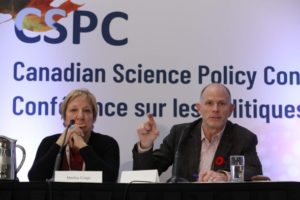

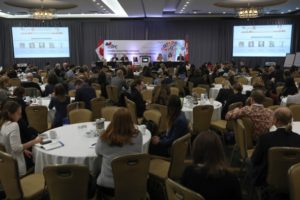
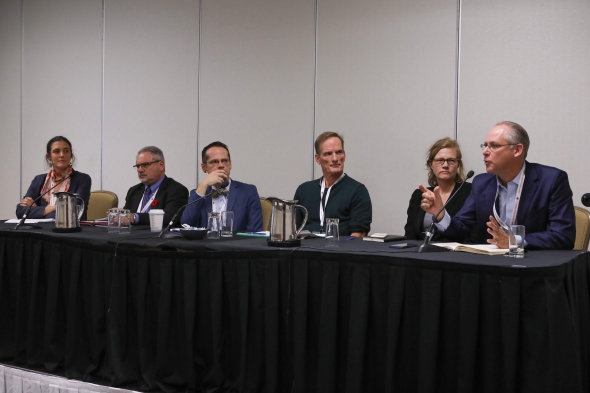
Day 3 – November 9th 2018
Takeaways and recommendations:
Connecting science with policy in Canada: How do I do it?
Organized by: Bird Studies Canada
Speakers: Mark Daley, Associate Vice-President (Research), Western University; Scott Findlay, Professor, Department of Biology at the University of Ottawa; Director of Graduate Studies at the Institute of Environment; Amy Luers, Executive Director, Future Earth; Frederick John Wrona, Chief Scientist, Alberta Environment and Parks; Christopher Ragan, Director of McGill University’s Max Bell School of Public Policy; Associate Professor, Department of Economics at McGill University; Chair of Canada’s Ecofiscal Commission
Moderator: Silke Nebel, VP Science and Conservation, Bird Studies Canada
Takeaways and recommendations
- Governments are creating multiple knowledge systems such as ensuring indigenous perspectives are included.
- It is important to consult broadly and to become a trusted advisor.
- Create expert panels and reviews of policy debates.
- Break down barriers and improve transparency in policy work and introduce scientific evidence.
- Do not underestimate the value of networking and building relationships.
- Policy groups like Evidence for Democracy are creating great opportunities for building bridges between science and policy development.
- Offer expertise and tools that can facilitate government policy work.
- Adjust faculty evaluations to include recognition of policy work and community engagement. However, the challenge is that deans currently oversee faculty evaluations, and many of our universities have organized labour constraints, which means that the roadblock to this being recognized and valued does not lie with administration but rather with the professoriate.
- Universities are incorporating new criteria for tenure to help to promote other work outside of scientific publication.
- Grassroots movements are changing how we manage the professoriate. We need to move beyond current criteria like putting too much weight on being a first author in a publication.
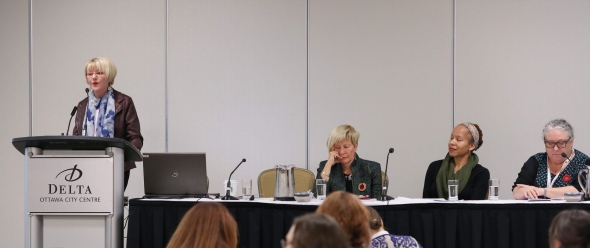
Day 1 – November 7th 2018
Takeaways and recommendations:
A 2-way street: Science informing policy and policy informing science
Organized by: The National Alliance of Provincial Health Research Organizations
Speakers: Denise Amyot, President and CEO, Colleges and Institutes Canada; Krista Connell, Chief Executive Officer, Nova Scotia Health Research Foundation; Necole Sommersell, Manager, Evaluation & Impact, Research Manitoba
Moderator: Deborah Gordon-El Bihbety, President & CEO, Research Canada: An Alliance for Health Discovery
Takeaways and recommendations:
- Scientific inquiry focuses on achieving a clear evidenced-based answer that can feed into evidence-based decision making.
- Policy development must take into account current issues, public opinion and the political climate.
- Policy makers may have to make decisions with incomplete information.
- Policy development has shorter timelines than scientific inquiry.
- Colleges and institutes are a useful resource for policy makers. They tend to focus on solving real-world problems affecting industry or communities. College research tends to work on shorter timelines, which could assist government in de-risking policy decisions.
Tip for scientists when contributing to policy development:
- Consult citizens and consumers before policies are drafted.
- Include under-represented and vulnerable populations in your consultations.
- Employ a multidisciplinary approach to ensure a holistic understanding of challenges and solutions.
- Pilot policies and adjust and tweak or cancel.
- Communications is critical to develop and sustain relationships between researchers and policymakers.
- Create a proof-of-concept and test it.
- Explore how you are sharing information and deploying knowledge translation.
- Engage stakeholders early in project design.
- Focus on dissemination of information.
- Use a champion to bridge communications, select someone who is respected, knowledgeable and understands the policy and science environments.
- Understand the power of storytelling.
When learning about policy development, remember:
- Do not bring things forward to policymakers that they cannot action.
- Make sure you understand the current policy agenda.
- Don’t become a threat. The push model is not as effective as understanding the culture and agenda of the government.
- Science informing policy is a complex arena.
- Communication is integral to success.
- Relationships are key.
- Ensure your communications is relevant, excellent, accessible and legitimate (REAL).
- Respond to public agenda and priorities, be relevant and on point.
- There is no point in sharing evidence that is not relevant or is overwhelming.
- Have excellent metrics, narratives and stories.
- Pilot projects are often a mechanism to garner more money and interest.
- Win hearts first and be personal, then share evidence.
- Lobbying simply means developing relationships.
- Focus on common goals, help policymakers make better decisions or do a better job for a province or the country.
- Become a trusted advisor; don’t focus on your needs only.
- Understand timing when it comes to political policies, and understand the current climate and what is on the agenda.
- Consider public opinion.
- You can use public opinion to push your agenda forward.
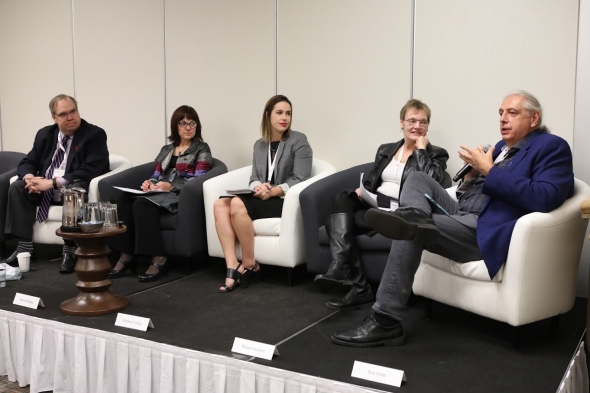
Day 2 – November 8th 2018
Takeaways and recommendations:
A 2-way street: Science informing policy and policy informing science
Organized by: The National Alliance of Provincial Health Research Organizations
Speakers: Denise Amyot, President and CEO, Colleges and Institutes Canada; Krista Connell, Chief Executive Officer, Nova Scotia Health Research Foundation; Necole Sommersell, Manager, Evaluation & Impact, Research Manitoba
Moderator: Deborah Gordon-El Bihbety, President & CEO, Research Canada: An Alliance for Health Discovery
Takeaways and recommendations:
- Scientific inquiry focuses on achieving a clear evidenced-based answer that can feed into evidence-based decision making.
- Policy development must take into account current issues, public opinion and the political climate.
- Policy makers may have to make decisions with incomplete information.a
- Policy development has shorter timelines than scientific inquiry.
- Colleges and institutes are a useful resource for policy makers. They tend to focus on solving real-world problems affecting industry or communities. College research tends to work on shorter timelines, which could assist government in de-risking policy decisions.
Tip for scientists when contributing to policy development:
- Consult citizens and consumers before policies are drafted.
- Include under-represented and vulnerable populations in your consultations.
- Employ a multidisciplinary approach to ensure a holistic understanding of challenges and solutions.
- Pilot policies and adjust and tweak or cancel.
- Communications is critical to develop and sustain relationships between researchers and policymakers.
- Create a proof-of-concept and test it.
- Explore how you are sharing information and deploying knowledge translation.
- Engage stakeholders early in project design.
- Focus on dissemination of information.
- Use a champion to bridge communications, select someone who is respected, knowledgeable and understands the policy and science environments.
- Understand the power of storytelling.
When learning about policy development, remember:
- Do not bring things forward to policymakers that they cannot action.
- Make sure you understand the current policy agenda.
- Don’t become a threat. The push model is not as effective as understanding the culture and agenda of the government.
- Science informing policy is a complex arena.
- Communication is integral to success.
- Relationships are key.
- Ensure your communications is relevant, excellent, accessible and legitimate (REAL).
- Respond to public agenda and priorities, be relevant and on point.
- There is no point in sharing evidence that is not relevant or is overwhelming.
- Have excellent metrics, narratives and stories.
- Pilot projects are often a mechanism to garner more money and interest.
- Win hearts first and be personal, then share evidence.
- Lobbying simply means developing relationships.
- Focus on common goals, help policymakers make better decisions or do a better job for a province or the country.
- Become a trusted advisor; don’t focus on your needs only.
- Understand timing when it comes to political policies, and understand the current climate and what is on the agenda.
- Consider public opinion.
- You can use public opinion to push your agenda forward.
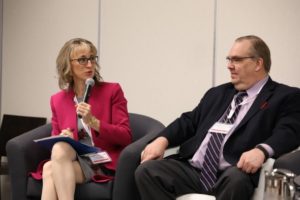
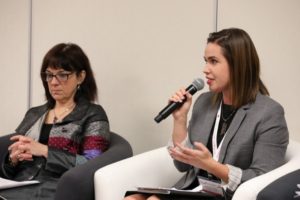

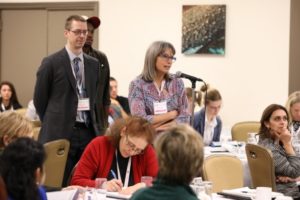
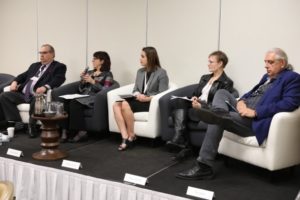
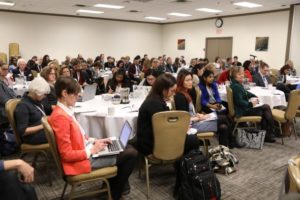
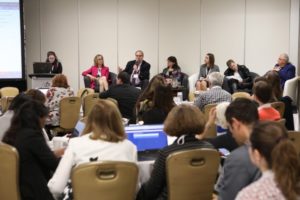

Day 1 – November 7th 2018
Takeaways and recommendations:
Shaping Science Policy to Improve Equity, Diversity and Inclusion (EDI)
Organized by: Fonds de recherche du Québec (FRQ), Fanny Eugène, EDI and Strategic Advisor
Speakers: Mary-Rose Bradley-Gill, Co-President, Science & Policy Exchange; Shirley Malcom, Director, Education and Human Resources Programs, American Association for the Advancement of Science; Denise O’Neil Green, PhD, Vice-President, Equity and Community Inclusion, Ryerson University; Anne Webb, Senior Policy Advisor Equity, Diversity and Inclusion, Natural Sciences and Engineering Research Council
Moderator: Maryse Lassonde, President, Conseil supérieur de l’éducation (Government of Quebec)
Takeaways and recommendations
- There is a growing body of evidence showing that greater EDI strengthens research by making it more rigorous, reliable and impactful.
- Fix the system, not the people. Changing one person, department, program or lab at a time is slow and far less effective than more systemic approaches. Build structures that help people learn about these issues.
- Barriers to EDI are experienced differently by different populations, age groups and contexts. Barriers can include:
- Unintentional and intentional biases
- Microaggressions
- Hostile work environments, stereotype threats
- Biased indicators of excellence
- Few role models
- Assumed linearity norm of research career paths
- Under-valued service and outreach contributions
- You can encourage industries and organizations to do the right thing by incentivizing, recognizing and rewarding positive behaviours (e.g., the Athena SWAN initiative, or in a different area, the LEED green building rating system).
- EDI is not a transactional sport; it is a relationship sport where you have to engage communities that have historically been marginalized. Engage equity professionals in identifying both the challenges and the solutions.
EDI case study: Quebec’s research granting agencies, the Fonds de recherche du Québec
- In 2018, the FRQ appointed its first EDI advisor (Fanny Eugène), and an EDI committee was formed that comprises all three Quebec research funds, to ensure EDI principles are applied and evaluated within its staff, communities and programs.
- Starting this year, the FRQ are implementing implicit bias training for personnel responsible for the evaluation committees and are inviting all reviewers to complete implicit bias training.
- The Strategic Clusters supported by the FRQNT (natural sciences, mathematics and engineering) are now being evaluated on their efforts toward EDI.
- FRQ grantees receive: paid parental leave for scholarship holders; travel expenses outside Quebec for post-doctoral fellows and their families; childcare during conferences and field explorations for researchers; and paid maternity leave for students supported by FRQNT grants.
- The Quebec Research and Innovation Strategy and the Strategy for Equality Between Men and Women each have specific measures to promote scientific careers to girls and women.
- FRQ and Quebec’s ministry of economy and innovation launched the SAGA Project, a UNESCO project that looks at policies and measures to promote gender equality in science and technology, from early childhood to adulthood. The Quebec group, involving participants from government, industry and academic, has identified 97 measures to support gender equality in STEM (report expected by end of 2018).
EDI case study: Initiatives in the United States
- The population of the U.S. does not look like the population of STEM. Participation rates are low among women and minority groups (i.e., Blacks, Latinos, Indigenous).
- Broadening participation among women and underrepresented groups is part of the National Science Foundation’s (NSF) mandate, largely as a result of the Equal Opportunities in Science and Engineering Act (1980).
- The NSF has had two main EDI programs that promote structural change: ADVANCE (to facilitate women’s advancement to the highest ranks of academic leadership), and the Alliances for Graduate Education and the Professoriate (AGEP) (for underrepresented minority doctoral students, postdoctoral fellows and faculty). The NSF’s new crosscutting INCLUDES initiative aims to support models that can lead to structural change.
- The AAAS hosts the Stem, Equity, Achievement (SEA) Change, an awards and recognition program adapted from the U.K. that takes a LEED-like designation approach to support institutional transformation. Key components are evidence-based self-assessments that can lead to institutional and departmental awards; development of a SEA Change Community and SEA Change Institute to support research and training for institutions related to EDI.
EDI case study: Canada’s tri-council agencies*
- Previous targeted efforts aimed at increasing opportunities for women and girls in science and engineering have not had the impact hoped for over the past 20 years. Current initiatives take a more systemic approach to improve EDI within research and among researchers.
- Based on shared objectives, the tri-agencies have developed an EDI action plan that combines their efforts and draws on international best practices to embed EDI considerations and analysis in policies, processes, programs and indicators of excellence. The action plan has two main shared priorities: equitable access to funding opportunities, and how applicants are treated once they are in the application process.
- The actions are being promoted, resourced, implemented and monitored. For example, additional staff are being hired for EDI initiatives, and resources and tools are being made available to reviewers to increase their awareness of bias.
- Developed tools and systems to collect and monitor data on underrepresented group participation in funding programs, peer review and going forward, on committees.
- Bias awareness training provided to reviewers and agency staff.
- Specific funding programs now include EDI-related recommendations in relation to personnel and research.
- Agency websites include guidance and resources related to EDI, and analysis in research, research teams and institutions.
- Agencies are integrating Gender-Based Analysis Plus (GBA+) into evaluation and policy reviews.
- For some agencies, a proportion of award holders who are underrepresented individuals is a performance indicator for monitoring and reporting to Parliament.
- Liaison with and alignment of EDI considerations with university research offices increased.
- Instituted new requirements for universities participating in the Canada Research Chairs program.
- Work is underway on the design and implementation of a made-in-Canada Athena SWAN program. A five-year pilot program, announced in Budget 2018, will be announced early next year.
- The tri-council participates in public forms to consult and engage external experts and knowledge holders on agency EDI initiatives.
* Tri-council: Natural Sciences and Engineering Research Council, Canadian Institutes of Health Research, Social Sciences and Humanities Research Council, Genome Canada and the Canada Foundation for Innovation
EDI case study: Ryerson University
- In 2012, Ryerson appointed its inaugural assistance vice-president/vice-provost of EDI.
- Later, the university realized that EDI was an important issue that needed to be elevated to help drive strategy direction, planning and decision-making for the whole organization. In response, in 2017 the university appointed its first vice-president, equity and community inclusion. This individual serves as a member of the president’s executive team and reports directly to the president.
- Too many EDI initiatives are designed and implemented without the assistance of EDI professionals. In February 2018, Ryerson and NSERC convened a roundtable in Toronto involving the federal research funding agencies, the FRQ, research professionals, academic leaders and EDI professionals to discuss how to make EDI happen. Among the themes to emerge from the roundtable:
- Persist in overcoming barriers to EDI
- Training needs to be reimagined and delivered in different ways “so it can stick”
- EDI is part of excellence, not EDI in spite of excellence
- System-wide accountability is paramount
- Leaders play an essential role in thinking about these problems and addressing them
- Have those difficult conversations around EDI; don’t avoid them
A student perspective on EDI
- Institutions can help promote EDI issues by providing funding and visibility to local groups that work in this space.
- The Science & Policy Exchange held an SPE Café in March, 2018: Breaking Gender Barriers in STEM (most participants were female graduate students). The group produced a report that identified seven gender barriers:
- Family planning: Standardize and encourage parental leaves, creative policies
- Criteria for excellence/merit: Revise criteria to take into account unconscious bias over a lifetime
- Hiring practices: Radical transparency
- Discrimination outside hiring (harassment to more unconscious): Sustainable positions for monitoring inclusion and diversity
- Role models and mentorship: Formalize mentorship programs, give credit
- Lack of men in the conversation: Leadership from the top, more equity and diversity training
- Societal pressures and unconscious bias we all hold: Financially and socially support conversations and dialogue
- The report also made 20 recommendations for addressing these barriers:
- Create awareness and transparency around rights for parental leave.
- Create parental leave plans for students/postdocs left out of coverage by specific grants.
- Create policies to better accommodate families – for example, childcare subsidies for students and postdoctoral fellows.
- Brainstorm creative solutions to foster a family-friendly environment.
- Revise the criteria used to judge merit for any type of application and nomination to reflect the reality that underrepresented groups are not on a level playing field and to value different types of merit (such as mentorship).
- Include discussions of implicit biases against female and minority candidates among hiring committee members before the hiring process begins.
- At the department level, implement written reports for each shortlisted candidate that should contain explanations on the final decision.
- At the institutional level, adopt a transparency policy for the hiring and promotions by publishing statistics annually.
- Consider the possibility of gender quota or reward system for hiring; explore different systems of implementation
- Create clear, accessible harassment policies that are enforced.
- Hold faculty accountable and be transparent about disciplinary actions.
- Clearly advertise process for reporting abuse.
- Establish sustainable positions for monitoring progress on equity, diversity, and inclusion.
- Improve equity training policies and provide up to date training.
- Collect and publish data about their policies and practices, based on clear targets and indicators of reduced harassment, bias, and discrimination.
- Incorporate equity, diversity, and inclusion training/discussion within each department’s core curriculum for students and faculty
- Re-evaluate traditional language used in reference to prestigious awards and opportunities.
- Financially and socially support conversations, dialogue, and specialized groups that will identify and propose targeted solutions for the specific group needs.
- Include students in discussions for equity, diversity, and inclusion.
- All leaders need to engage, including and especially men
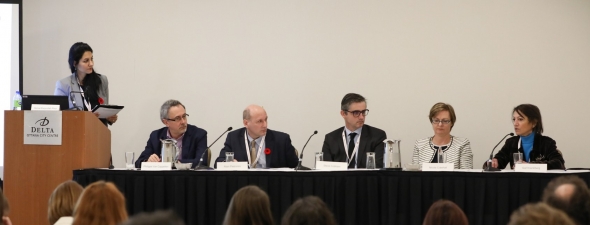
Day 2 – November 8th 2018
Takeaways and recommendations:
Water at the science-policy interface: Challenges and opportunities for Canada
Organized by: The University of Waterloo, Tatjana Milojevic and Nancy Goucher
Speakers: Philippe Van Cappellen, Canada Excellence Research Chair in Ecohydrology Laureate; Steve Cobham, Manager of Canada-U.S. Relations in the International Affairs Branch, Environment and Climate Change Canada; Nicola Crawhall, Principal, Westbrook Public Affairs; Gail Krantzberg, Professor of Engineering and Public Policy in the Walter G Booth School of Engineering Practice and Technology, McMaster University; Alain Pietroniro, Executive Director for the National Hydrological Service within the Meteorological Service of Canada, Environment and Climate Change Canada
Moderator: Homa Kheyrollah Pour, Research Scientist, University of Waterloo
Takeways and recommendations
Context
- Historically, the concern for water pollution was focused on point-source stressors, such as effluent from a factory, which was relatively easy to identify and address.
- Now we are learning more about the impact of non-point-source stressors such as nutrient enrichment and their effects can be compounded by climate change and interaction with other stressors.
- These are “wicked problems” because solutions involve trade-offs between ecology, economics, and stakeholders – there is no perfect solution.
Opportunities
- Boundary groups who facilitate the science-policy interface can reduce the cost to researchers for communicating with policymakers. This doesn’t mean we need to create new organizations – there are many that currently exist (e.g. International Joint Commission (IJC)). It is important these organizations remain as neutral, evidence-based as possible. They can do themselves a disservice when they don’t stay neutral).
- Solutions these days require us to make trade-offs.
- No single solution will satisfy all stakeholders or return ecosystem to pristine conditions.
- People (and skillsets) are needed to fill gap between science and policy.
- Customize science to be relevant to policy.
- Boundary organizations can help translate to allow science to be more easily relevant.
- Reduce translation costs for academics.
- Metrics and tools are needed to understand science-policy.
- E.g., Valuation of ecosystem services (loss of wetlands can cost hundreds of millions/ year)
- Measuring ecosystem services can be used to make an economic evaluation and determine the replacement cost of a water system.
- Economies of scale work in monitoring fresh water in Canada. For instance, there are provincial/federal partnerships where provinces pay the federal government to conduct monitoring operations.
- At the federal level, water monitoring is operational – there isn’t a lot of time to come together with scientists to develop new innovative systems.
- Fiscal realities and a relatively low profile often dictate resistance to increasing water monitoring. Are there other options? The issue is often not visible to the public until there is a crises or extreme event. Public memories are relatively short.
- Science and policy timeframes are different: science may say that if we make a change now, we will see the outcome in years or decades. Politicians are driven more by shorter term election cycles. As such, adaptive management approaches may be helpful in enabling policy to be developed based on best available science and updated once more is known.
- Policymaking needs to be more agile and less linear (problem, analysis, decision, funding). Approach more flexible manner.
- Water policy development and implementation in Ontario is complicated by the number of players involved (i.e., municipal, provincial, federal). The trend towards devolution of responsibilities for water to local communities and private owners is problematic in terms of access to science and knowledge.
- The source water protection program in Ontario is an interesting example of the science-policy interface. Science was used to develop source protection policies. Now Risk Management Officials are responsible for working with landowners to figure out how to implement those policies on a case-by-case basis. Their job is to:
- Broker information: science and regulations
- Communicate the risks to drinking water from local activities
- Negotiate between stakeholders
- The source water protection program in Ontario is an interesting example of the science-policy interface. Science was used to develop source protection policies. Now Risk Management Officials are responsible for working with landowners to figure out how to implement those policies on a case-by-case basis. Their job is to:
- Having a staff member dedicated to water at the municipal level is resource-intensive. Can we support those budgets?
- Canada needs to invest in monitoring and science. Lake Erie is in distress due to algal blooms that form because of increased inputs of phosphorus (fertilizer). Canada has provided little monitoring data to support a Canada-U.S. understanding of this problem. Canada is relying on computer models and extrapolated data from the US.
- Train policymakers in science and vice versa. Each group needs to better understand one another. Policymakers ask different questions – why should we take action at this time? Scientists ask about how the world works, and relationships between factors. They experiment, learn by doing, reduce uncertainty, improve understanding with increasingly better certainty. Preventative action is very hard for a policymaker to take because we already have so many issues in a crisis mode. Improving mutual understanding of the pressures and perspective of one another can help identify a common path forward.
- If scientist or engineer wants to have impact, they need to learn soft skills, politics, and legal instruments so their uncertainty can be accommodated.
- Look for opportunities for policy to move faster. Microbeads is a good example and happened for a number of reasons:
- The scientists did a great job communicating results and impact.
- The issue was tangible and the impact on people was clear (and also involved children). People felt deceived by the companies they were buying product from and industry was willing to act because of public pressure.
- Provide opportunities for scientists and policymakers to connect more frequently (e.g., seat them together in the same part of the office).
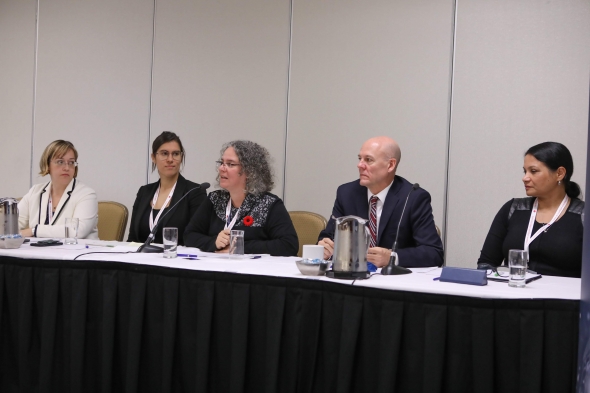
Day 1 – November 7th 2018
Takeaways and recommendations:
New Ways of Informing Policy by Leveraging Scientific Knowledge: Two Models Related to Public-Academic Collaborations
Organized by : Social Sciences and Humanities Research Council of Canada (SSHRC), Chantal Barton
Speakers : Bipasha Baruah, Canada Research Chair in Global Women’s Issues, Western University; Ian Clark, Chief of the Economic Research, Science Integration and Outreach Division, Natural Resources Canada; Ioanna Sahas Martin, Director for International Assistance Research and Knowledge, Global Affairs Canada; Maïka Sondarjee, SSHRC Doctoral Candidate, University of Toronto
Moderator : Madeline Johnson, Foreign Service Officer, Global Affairs Canada
Takeaways and recommendations
Collaboration between academics and government is key
- Public servants are fortunate to work in a public service where evidence-based policymaking and working with external partners is valued.
- A lack of information and knowledge isn’t the problem. Rather, people don’t always know how to access that information or use it. Government officials need to access information easily and understand how to turn it into policy.
- Academics need to be more policy-oriented, and government agencies need to value research more.
- Both external researchers and government policymakers draw on different capacities, but it is the collaboration between the two that produces the highest quality and most valuable research and best strengthens the evidence base for policy.
- It is critical to foster more and more effective collaborations between them.
- To do this, researchers and policymakers need more opportunities to interact and build partnerships.
Barriers for academic engagement in the public sector
- Academia and government, especially in Canada, do not have a history of employees moving between them. We need to create more opportunities for such exchanges.
- The United States and United Kingdom are examples of societies where the barriers between the two sectors are more porous.
- The academic incentive system can be a barrier to outside engagement, although this is changing. All knowledge translation work needs to be valued.
- There are more opportunities for early-career and late-career researchers to get involved as mid-career researchers are often focused on time-consuming activities that lead to tenure (i.e., publishing in peer-reviewed journals) and starting families.
- Policymakers should recognize this reality and target early- and late-career academics, while academic institutions should create more opportunities and incentives for mid-career researchers to collaborate with the public sector.
- Marshaling government collaboration through the contracting process (i.e., procurement) can be difficult, cumbersome and time consuming.
Expanding academic training
- Academics need to train for more than just being university professors – especially since there are not very many jobs in this area.
- Academic training needs to include training for communicating complex ideas to a general audience.
- Academics need to learn to write for a policy-oriented audience, to apply their work to policy fields and to value policy writing and policy partnerships.
Policymakers need to welcome and value academic researchers
- Researchers have varied skills, beyond their specific research field, that can be applied to different areas and ideas. Researchers need to be able to articulate these skills, and policy makers need to understand and value them.
- Government departments need to provide academics, particularly young researchers, more opportunities to interact with policymakers.
- Bringing aboard young researchers creates long-term relationships and gives government access to a pool of amazing brains that can be brought in on other research projects.
- A small monetary investment can yield high results when hiring young researchers.
- External researchers help deliver high quality research that includes robust and evidence-based recommendations.
- Bringing in outside researchers can offer a different viewpoint, helping policy makers in identifying new issues or gaining a fresh perspective on older ones.
- Outside perspectives can also help governments break down departmental silos. Often it can be easier for an outsider to explain the context of why and how policy issues are multi-departmental.
- Short-term research needs are hard to deliver in government departments given the focus on day-to-day pressures and priorities. To meet those shorter timelines departments have to shift priorities, make organizational changes or increase their recruitment efforts to bring in more researchers. It can be easier and more affordable to bring in an outside researcher for such a project.
- Academics are more nimble than government scientists – in addition to shorter-term projects, they can take on a wider range of research topics with longer horizons.
- Increasingly, academics apply a multidisciplinary approach to their research.
- Lots of data are collected by government but are not being used. Academic researchers could help with data analysis.
Policymakers bring strengths to the collaboration
- The policy community brings insider knowledge and perspective on emerging government priorities. They ensure a policy lens is brought to bear through the entire collaboration.
- Having the end users of research involved helps to ensure that the right questions to explore are being asked from the beginning.
- Some departments, like Natural Resources Canada (NRCan), can adopt a cross-sectorial approach to identify knowledge gaps.
- Within NRCan, there are a variety of expert working groups whose resources and expertise can be leveraged to implement and guide the collaboration.
- Government workers can help navigate tricky procurement processes.
- Policymakers can ensure that research findings have actual policy relevance and will produce recommendations that are realistic and can implementable by senior management.
How academics benefit
- Interacting with government can give researchers insight into policymaking processes and the tangible uses of their research in that context, help them make new connections and build relationships, and contribute to more informed decisions about future research.
- Researchers may learn to communicate their research in a new way, and how to frame it in a real-world context.
- Accessible communications is not “dumbing-down” the research. Rather, it’s about the ability to translate information to different audiences.
- Some findings in academia initially seem to be unrelated to the policy world, but may actually be very useful in a broad range of policy contexts, if aptly apply to these contexts.
Examples of effective collaboration models
- The International Policy Ideas Challenge (IPIC), a partnership between SSHRC and Global Affairs Canada (GAC), gives graduate students and emerging scholars opportunities to inform priority policies with evidence that policymakers understand and can put into practice.
- IPIC is a unique way to leverage scientific knowledge into the policy world and we need more programs like it.
- NRCan’s Economic and Policy Research Agenda works with academics to strengthen evidence-based decision making, address knowledge gaps on emerging NRcan’s proprieties, build capacity to respond to longer-term and cross-cutting challenges and enhance partnerships with external research experts.
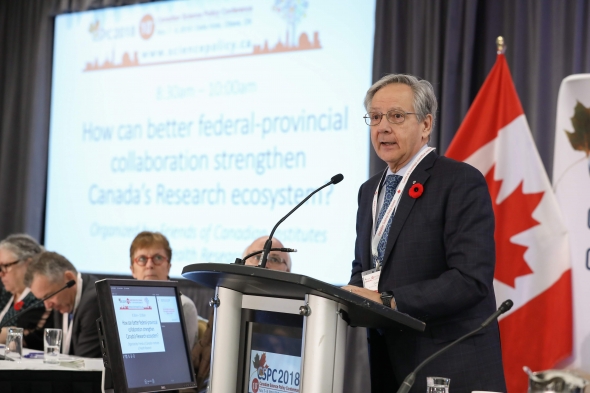
Day 1 – November 7th 2018
Takeaways and recommendations:
How can better federal-provincial collaboration strengthen Canada’s research ecosystem?
Organizers: Friends of Canadian Institutes of Health Research (FCIHR) and the Henry G. Friesen International Prize program
Speakers: Krista Connell, Chief Executive Officer, Nova Scotia Health Research Foundation; Dr. Janet Rossant, PHD FRS FRSC, President and Scientific Director, Gairdner Foundation; Marc LePage, President and CEO, Genome Canada; Dr. David Naylor, 2018 Friesen Prizewinner; Professor of Medicine and President Emeritus at the University of Toronto; Dr. Mona Nemer, Chief Science Advisor, Government of Canada; Dr. Michael J. Strong, President, Canadian Institutes of Health Research (CIHR)
Moderator: Dr. Gilles Patry, Executive Director, U15
“Our full potential in science will only be realized with a highly collaborative ‘Team Canada’ strategy”: David Naylor
The 2018 federal budget delivered a long-awaited boost for science in Canada. But if the country wants to make the most of these new investments, it needs the federal government, provinces and territories to do a better job at coordinating research funding and priorities.
That was the main message CSPC delegates heard from Dr. David Naylor, who chaired a blue-ribbon panel that in 2017 produced Canada’s Fundamental Science Review, also known as the Naylor Report.
Though this seminal report primarily focused on federal issues related to the funding, organization and oversight of extramural science, it also included several observations related to the interplay of federal and provincial/territorial (FPT) support for research, innovation, and talent development, notably:
- Very limited FPT interaction and shared strategizing among senior officials on the science and innovation files
- Obvious imbalance of financial support for research across Ottawa, the provinces, and institutions
- Specific friction points: e.g., sharing of Facilities and Administrative Costs (also termed indirect costs), federal programs requiring Provincial or Territorial match funding without collaborative adjudication
- Weak alignment on shared challenges such as research infrastructure/infostructure
- Absence of a shared vision and national action plan for developing research-intensive talent
In Canada, research is a shared jurisdiction between the federal and provincial governments, one where the federal government has traditionally played a major role. But as Dr. David Naylor noted, “the interprovincial variation is dramatic in terms of how research is funded.”
The solution, said Naylor, is to make science “truly national” through greater federal-provincial-territorial [FPT] coordination, as well as better cooperation among provinces and territories, with the federal government contributing as both a facilitator and funder.
“You often hear that Canada punches above its weight [when it comes to science], but the reality is we make that weight ever smaller by being divisive,” said Naylor. “This regionalism is increasingly unhelpful, especially in areas like science, scholarship and inquiry where we need to pull together to make maximum impact.”
Naylor said provinces “frequently chafe” when a federal program they had little or no input into requires them to contribute a disproportionate amount of the matching funding for something that may not align with provincial priorities. Another flash point is the indirect costs of research.
“The institutions, and the provinces that support those institutions, are often put in a position of backfilling around federal grants, to keep the lights on and maintain buildings and libraries,” said Naylor.
Areas that would benefit from increased collaboration include harmonized funding for big science projects like digital infrastructure, as well as a shared vision and national action plan for developing talent and supporting researchers at all stages of their careers.
“Despite occasional laments that we have too many PhDs and researchers, the fact is that this country under-employs researchers and scientists” compared to many OECD peer nations, said Naylor.
Opportunities for FPT collaboration
Canada’s Chief Science Advisor, Dr. Mona Nemer, agreed that Canada’s future as an innovation nation depends on stronger links between all levels of government, including municipal. She identified three specific challenges in need of solutions:
- How to develop national action plans in different areas (e.g. use of data in health research)
- Talent development
- Defining “big science” and figuring out how operational costs be sustainably supported
“Talent development is a particularly vexing issue,” that would benefit from more FPT coordination, said Nemer. She noted that post-secondary institutions are growing their student ranks. That generates more PhD candidates, which in turn increase demand for physical space, more professors, and ultimately more federal research funding.
Recent initiatives are creating opportunities for better collaboration, said Nemer. The Digital Research Infrastructure Strategy, for example, has led to stronger connections between Ottawa and the provinces, and opened the door for better strategic planning, including funding for big infrastructure.
Having a national science advisor as well as provincial science advisors can also improve both communication and coordination, she added. “It takes those conversations out of the political realm.”
Dr. Michael Strong, the new President of the CIHR, encouraged delegates to read a new University of Toronto report on FPT coordination in research and innovation funding. A Delicate Balance identifies 7 coordination goals, which Strong described as logistical challenges that can be overcome with better engagement:
- Avoiding or minimizing duplication and overlap
- Avoiding program inconsistencies
- Minimizing bureaucratic conflict
- Ensuring coherence and cohesion
- Agreeing on priorities
- Improving the efficiency in the way funding is allocated
- Promoting a comprehensive, “whole-of-government” perspective on the policy issue
One area where these approaches are working with is CIHR’s Strategy for Patient-Oriented Research initiative, which has established national collaborative research networks across the country. SPOR Networks involve researchers, patients, policy makers, academic health centres, health charities, and other stakeholders.
“SPOR is probably one of the most innovative programs we’ve done in this country to bring together federal, provincial and territorial partners – true partners where we’re looking at issues with regard to health care outcomes and how to we can make changes in real time that are meaningful to the population,” said Strong, adding, “We’re five years into a 10-year experiment where we’re starting to see results already.”
CIHR’s Health System Impact Fellowships are another example of effective FPT collaboration, said Strong. The fellowships provide doctoral trainees and post-doctoral fellows with opportunities to work with provincial health agencies and other non-academic health players to apply their research to critical challenges in health care.
Another success has been the National Alliance of Provincial Health Research Organizations (NAPHRO), which facilitates coordination, communication, strategic alignment and convergence, and quality leadership through interprovincial and national efforts. Strong said the group has identified barriers, for example, that will allow provinces and the federal government to begin planning now for the future human resource needs of each region.
“We are also looking at the tools that for the very first time will allow us to have the metrics that measure the needs within our population and do appropriate forward projections,” said Strong, adding that such data will help CIHR to set future priorities.
One of those priorities is ensuring students realize the opportunities of a career in research beyond academia. “I will bring no proposal forward to our government for funding that does not have capacity development embedded in it.”
The need for a national framework
If Canada wants to win future Gairdner or Nobel prizes, it needs “a coherent framework for research funding that sees granting agencies funding all research – from fundamental discoveries to application,” said Dr. Janet Rossant, who leads the Gairdner Foundation.
“We have a disruptive and disperse funding structure in Canada and Canadian researchers are very good at dealing with that mosaic but at the cost of potentially overlapping grant applications and a lack of clear national vision,” she told delegates.
Current and prospective research investors, including industry and philanthropy, should be part of that vision exercise, said Rossant. The Perimeter Institute in Waterloo, ON, for example, is a model for how industry, government and foundations can come together to support fundamental research.
Public-private partnerships are common in the U.S. In September, Facebook founder Mark Zuckerberg and his wife Priscilla Chan contributed US$13 billion to create the Chan Zuckerberg Initiative, which has the goal of curing, preventing or managing all diseases “in our children’s lifetime”.
“These are large sums of money being invested in basic, single cell biology,” said Rossant. “This idea of building linkages between donors, governments and advocates can help us come together in partnerships that can extend beyond our national borders to push against the boundaries of current knowledge and move us forward. But it requires vision and leadership.”
The time is ripe, she added, “to take a higher look at a truly integrated partnership between all levels of government and other partners, to develop a strategic process to identify projects of national and international importance where Canada can take a lead and where we will see the next Gairdner and Nobel Prize winners.”
The role of national programs
Instead of talking about federal programs, the focus should be on national programs that engage multiple partners from across the country on both research and innovation, said Dr. Marc LePage, President/CEO of Genome Canada, a national program that receives about $170 million annually – $70 million from Ottawa with the remainder coming from the provinces, industry and foundations.
To get there, you need “boots on the ground”. Genome Canada has six regional centres across the country.
“They are completely separate from Genome Canada,” said LePage. “They have their own boards. They’re anchored in their communities. Their job is to organize their communities, connect with their provincial governments and together we try to develop programs that are nationally coherent and very locally anchored.”
Genome Canada is able to respond to those regional needs – while also leveraging more funding and infrastructure – by supporting a broad range of genomics research, including health, agriculture and agri-food, forestry, fisheries and aquaculture, environment, energy and mining.
“We’re the only country where we have this integrated program,” said LePage. That integration has resulted in genomics technologies developed for health now used in agriculture and forestry, “and a lot faster than other competing nations,” said LePage.
However, he cautioned that transformative technologies such as genomics or artificial intelligence require research capacity in all regions because of the social and economic implications of these new technologies.
“We have to look nationally – how do we compete globally, but we also have to look regionally to ensure we have full access and full distribution of capacity,” said LePage.
It’s not all about the money
The big problems with Canada’s research ecosystem are the “result of a disjointed, ad hoc, incremental and often dysfunctional approach”, said Krista Connell, who brought a provincial perspective to the discussion as CEO of the eightteen-year-old Nova Scotia Health Research Foundation.
She explained that provinces, the federal government and federal agencies develop research plans in isolation of each other which has created different approaches to funding, peer review and competition processes, as well as overlapping timeframes.
Connell is also a founding member of NAPHRO, established in 2013 to help provinces better understand the federal research ecosystem and to identify common challenges and solutions. One success has been the adoption of a unified approach to health research impacts measurement, using the Canadian Academy of Health Sciences (CAHS) framework for measuring return on investment in health research.
“NAPHRO members collectively pooled their evaluation expertise and we developed a process for implementing and enhancing this framework for health research,” said Connell.
NAPHRO was formed in 2002 but it would take several years before its members were widely recognized for their expertise, contributions and strong links to provincial governments. Today, NAPHRO is a regular contributor to CSPC panels. It was also consulted as part of Canada’s Fundamental Science Review.
Connell urged federal players to engage NAPHRO to understand provincial challenges and priorities. More importantly, engage early in the development of new national programs to ensure alignment with regional priorities.
Those discussions are no longer limited to health research. Connell noted that many NAPHRO members are expanding their mandates to include more areas of research.
“Having conversations with us will go a long way to dealing with the FPT tensions… It is critical to understand that we do not just want to be at the table, we should be at the table because we can help improve things greatly.”


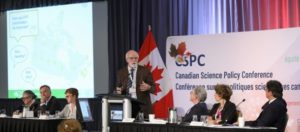
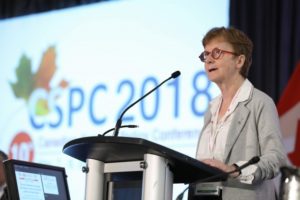
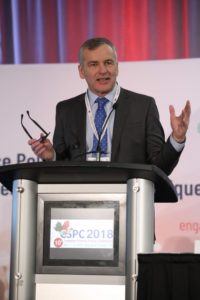
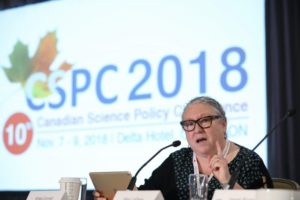

Day 3 – November 9th 2018
Takeaways and recommendations:
Takeaway and notes will be available soon

